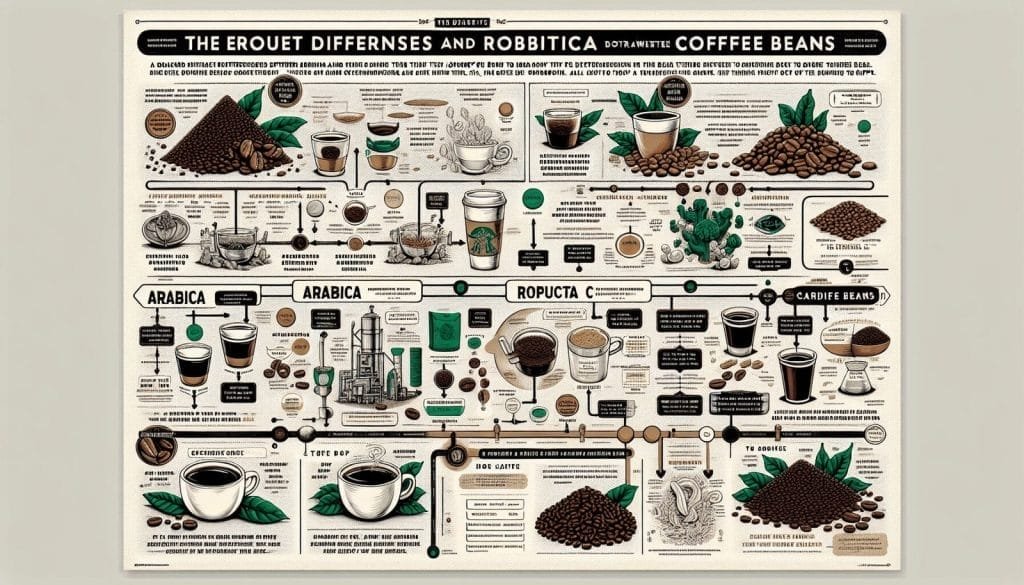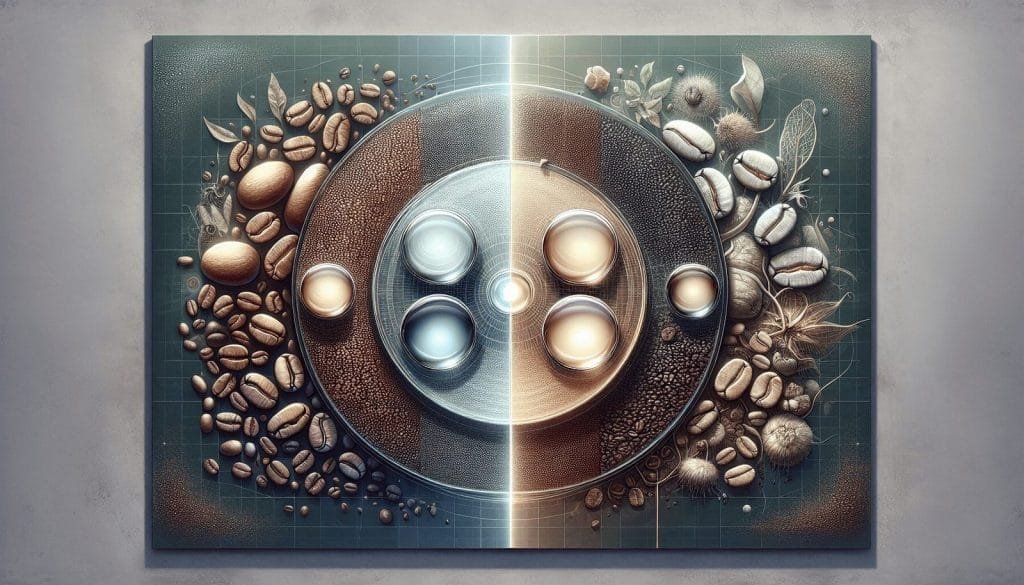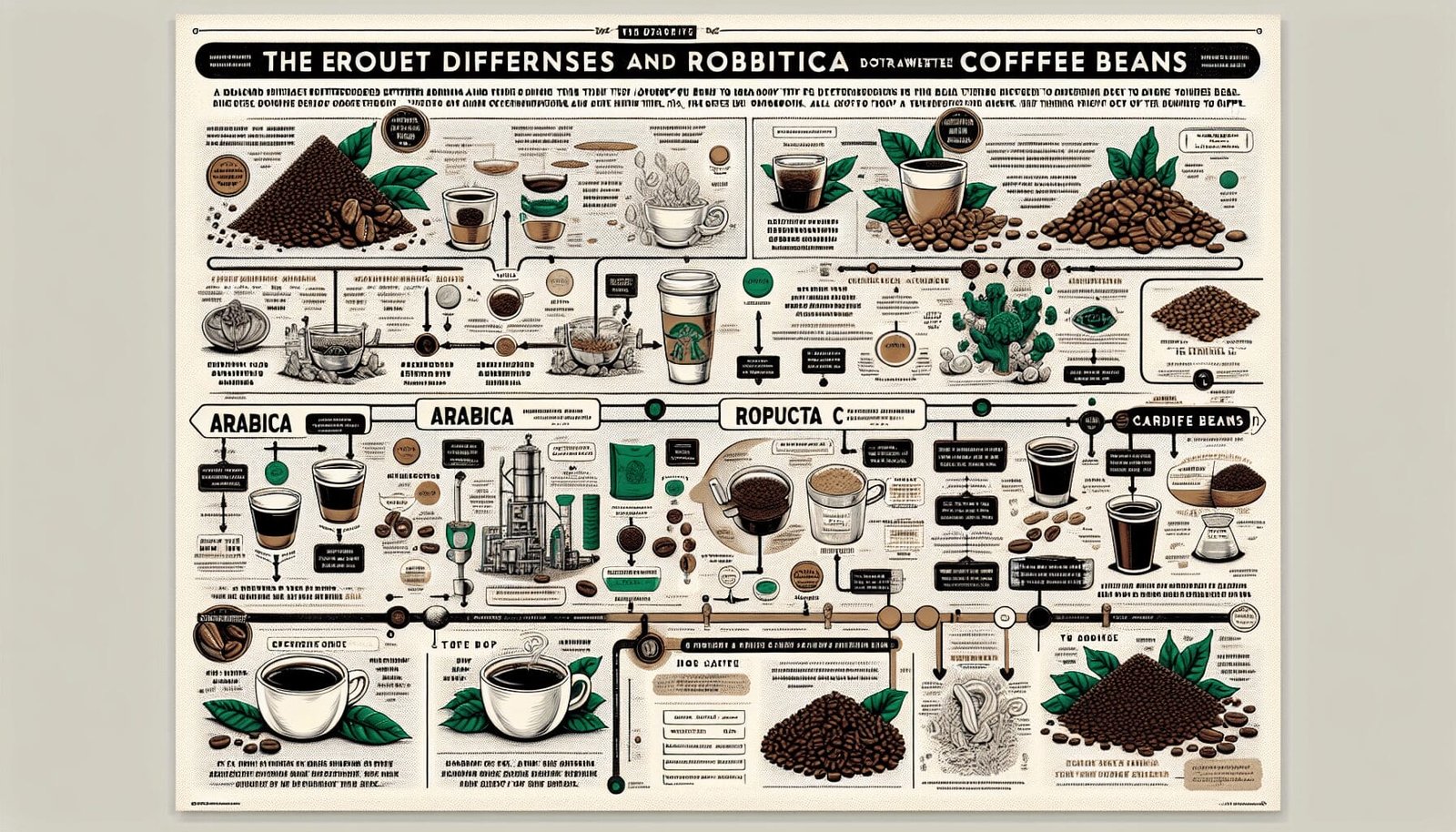Step into the world of coffee and unravel the mystery behind Starbucks’ choice of beans. Have you ever wondered whether Starbucks uses Arabica or Robusta? In this article, we will explore this intriguing question that has fueled coffee enthusiasts’ curiosity for years. Get ready to dive into the captivating realm of Starbucks’ coffee selection and discover the secrets behind their enticing brews.

Origin of Arabica and Robusta coffee beans
Arabica coffee beans
Arabica coffee beans, scientifically known as Coffea Arabica, originated from the highlands of Ethiopia. This variety accounts for the majority of the world’s coffee production, making up approximately 70% of the global market share. Arabica beans thrive in high altitude regions with rich volcanic soil, such as parts of Central America, South America, and Africa.
Robusta coffee beans
Robusta coffee beans, scientifically known as Coffea Robusta, have their origins in the lowland forests of sub-Saharan Africa. Robusta beans are hardier and more resistant to diseases and pests compared to Arabica beans. They are grown at lower altitudes in regions like Vietnam, Brazil, and parts of Africa. Robusta beans make up around 30% of the world’s coffee production.
Key differences between Arabica and Robusta
Taste and flavor
Arabica coffee beans are renowned for their complex flavor profiles and delicate aromas. They have a smoother, sweeter taste with notes of fruit, chocolate, and caramel. On the other hand, Robusta beans have a stronger and more bitter taste with earthy and nutty undertones. They often exhibit higher levels of acidity, which contributes to their distinct robustness.
Caffeine content
One of the notable differences between Arabica and Robusta beans is their caffeine content. Arabica beans contain less caffeine, usually ranging between 0.8% and 1.4%, while Robusta beans have higher caffeine levels, averaging between 1.7% and 4%. The higher caffeine content in Robusta makes it a popular choice for those seeking a strong and energizing cup of coffee.
Growing conditions
Arabica beans thrive in cooler climates and require higher altitudes for optimal growth. They are more susceptible to diseases and pests, demanding careful cultivation practices. In contrast, Robusta beans are more resilient and can tolerate hotter temperatures and lower altitudes. They have a higher resistance to diseases and are easier to cultivate, which contributes to their lower production costs.
Physical appearance
Physically, Arabica coffee beans have an oval shape and a curved crease down the middle, resembling a classic coffee bean shape. Comparatively, Robusta beans are typically rounder and have a straight crease. The size of the beans also differs, with Arabica beans being larger and flatter, while Robusta beans are smaller and rounder.
Cost
Due to the differences in growing conditions and taste profiles, Arabica beans are generally priced higher than Robusta beans. The delicate cultivation requirements, limited growing regions, and higher demand contribute to the higher cost of Arabica coffee. Robusta beans, being more readily available and easier to cultivate, are often sold at a lower price point.
Starbucks’ coffee sourcing strategy
Commitment to Arabica
Starbucks, as one of the world’s largest coffee chains, has a strong commitment to sourcing Arabica coffee beans. Their goal is to provide customers with the highest quality Arabica beans, which they believe offer superior taste and flavor experiences. Starbucks works closely with coffee farmers and cooperatives in various regions to ensure sustainable and ethical practices throughout the supply chain.
Blending with Robusta
While Arabica beans form the foundation of Starbucks’ coffee offerings, the company recognizes the unique characteristics of Robusta beans. Starbucks expertly blends Robusta beans with Arabica beans to achieve specific flavor profiles and enhance certain coffee blends. By incorporating a small percentage of Robusta beans, Starbucks can add depth and intensity to its espresso blends and certain beverages.
Fairtrade and ethical sourcing
Starbucks places a strong emphasis on fairtrade and ethical sourcing practices. The company works directly with coffee farmers, providing them with fair prices for their crops and supporting sustainable farming practices. By implementing ethical sourcing initiatives, Starbucks aims to improve the livelihoods of coffee farmers and contribute positively to the communities from which they source their coffee beans.
Partnering with coffee farmers
Starbucks actively partners with coffee farmers worldwide through various programs and initiatives. These partnerships focus on long-term relationships and mutual support, with Starbucks providing training and resources to help farmers improve their cultivation practices and increase yields. These collaborations not only ensure a reliable supply of high-quality beans but also foster economic development in coffee-producing regions.
Arabica dominance in Starbucks’ offerings
Preference for Arabica
In line with the global preference for Arabica coffee, Starbucks predominantly offers Arabica-based coffee blends and single-origin options. The company believes that Arabica beans offer a more nuanced and enjoyable coffee experience, catering to a wide range of consumer palates. The majority of Starbucks’ core coffee options, such as Pike Place Roast, Veranda Blend, and Guatemala Antigua, are primarily Arabica blends.
Robusta usage in certain blends and beverages
Although Arabica beans are the star of Starbucks’ coffee selection, the company recognizes the role that Robusta beans play in creating distinct flavors and enhancing certain blends and beverages. Some of Starbucks’ darker roast blends, like French Roast and Espresso Roast, incorporate a small percentage of Robusta beans to add richness and depth. These carefully crafted blends strike a balance between the smoothness of Arabica and the strength of Robusta.
Specialty limited editions
As part of their commitment to offering diverse choices and unique coffee experiences, Starbucks occasionally introduces specialty limited edition blends that showcase the qualities of both Arabica and Robusta beans. These limited offerings provide customers with an opportunity to explore the unique flavor profiles that result from the combination of these two coffee varieties.

Arabica vs Robusta in Starbucks’ core beverages
Espresso-based drinks
Starbucks’ iconic espresso-based drinks, such as lattes, cappuccinos, and macchiatos, primarily feature Arabica beans. The smoothness, balance, and nuanced flavors of Arabica contribute to the complexity and richness of these popular beverages. However, in their quest to create the perfect espresso shot, Starbucks may include a small percentage of Robusta beans in their espresso blends to enhance the crema and add more intensity to the flavor.
Drip brewed coffee
When it comes to drip brewed coffee, Starbucks consistently uses Arabica beans as the foundation for their offerings. Arabica beans are well-suited for drip brewing methods, allowing the flavors to fully develop and providing a smooth and enjoyable cup of coffee. Starbucks’ commitment to high-quality Arabica beans ensures that customers receive a consistently excellent drip brewed coffee experience.
Iced coffee and cold brew
In the realm of iced coffee and cold brew, Arabica beans continue to dominate Starbucks’ offerings. The naturally sweet and aromatic characteristics of Arabica beans complement the refreshing and smooth nature of these chilled beverages. By utilizing Arabica beans in their iced coffee and cold brew creations, Starbucks aims to deliver a satisfying and flavorful coffee experience even in the heat of summer.
Blending Arabica and Robusta for unique flavors
Starbucks reserve blends
Within their Starbucks Reserve line, the company showcases their expertise in blending Arabica and Robusta beans to create unique and distinctive flavor profiles. Starbucks Reserve blends are handcrafted, small-batch offerings that highlight the rare and exceptional qualities of select coffee beans. By carefully selecting and blending both Arabica and Robusta beans, Starbucks strives to create unforgettable taste experiences for coffee enthusiasts.
Balancing flavor profiles
By blending Arabica and Robusta beans, Starbucks can balance the flavor profiles of their coffee offerings. The smoothness and subtle flavors of Arabica can be complemented by the added intensity and richness of Robusta. This balanced approach allows Starbucks to cater to a diverse range of tastes, ensuring that every customer can find a coffee blend that suits their preferences.
Creating signature blends
One of Starbucks’ strengths lies in their ability to create signature blends that stand out in a crowded coffee market. Blending Arabica and Robusta beans is a key factor in the development of these unique and proprietary blends. By combining the distinctive characteristics of each type of bean, Starbucks can offer exclusive flavors and experiences that cannot be replicated elsewhere.
Coffee blends and single-origin options
Blends offered by Starbucks
Starbucks offers a wide range of coffee blends to cater to various tastes and preferences. These blends typically feature carefully curated combinations of Arabica beans from different regions. By blending beans from multiple origins, Starbucks can achieve a harmonious flavor profile that highlights the best qualities of each coffee varietal, resulting in a well-balanced and enjoyable cup of coffee.
Single-origin coffees
In addition to their blends, Starbucks also provides single-origin coffees that allow customers to explore the unique characteristics of coffee beans from specific regions. These single-origin options showcase the terroir and distinct flavor profiles of Arabica beans grown in different parts of the world. From the citrusy brightness of Ethiopian Yirgacheffe to the nutty sweetness of Colombian coffee, Starbucks’ single-origin offerings provide a journey of tastes and experiences.
Arabica blends from different regions
Starbucks recognizes the diverse flavors and nuances that different regions bring to Arabica coffee. By sourcing beans from various coffee-growing regions such as Latin America, Africa, and Asia-Pacific, Starbucks can offer a wide selection of Arabica blends that showcase the unique flavors and aromas from each origin. This approach allows consumers to explore the rich diversity of Arabica coffee while experiencing the quality and consistency associated with the Starbucks brand.
Unique Robusta offerings
Although predominantly known for their commitment to Arabica coffee, Starbucks occasionally introduces unique offerings that highlight the qualities of Robusta beans. These limited edition blends or single-origin Robusta options provide an alternative coffee experience for those seeking a bolder and more robust flavor profile. While not as prevalent in Starbucks’ core offerings, these unique Robusta options add an element of excitement and experimentation to the coffee selection.
Certifications and quality control
Starbucks’ commitment to quality
Quality control is of utmost importance to Starbucks. To ensure consistency and the highest standards, Starbucks employs rigorous quality control measures throughout the coffee sourcing and production process. From selecting and testing the beans to monitoring the roasting and brewing processes, Starbucks’ commitment to quality plays a pivotal role in the success and reputation of their coffee offerings.
Certifications for Arabica and Robusta
Both Arabica and Robusta beans can be certified by various organizations to ensure they meet specific standards. Starbucks actively seeks out and partners with coffee farmers who adhere to certifications such as Fairtrade, Organic, and Rainforest Alliance. These certifications not only validate the quality and sustainability of the beans but also provide assurance to customers that their coffee is ethically sourced and produced.
Testing and tasting processes
Before any coffee beans make their way into Starbucks stores, they undergo rigorous testing and tasting processes. Starbucks’ team of expert coffee tasters, known as “coffee masters,” evaluate the beans for characteristics like flavor, aroma, acidity, and body. This meticulous testing ensures that only the highest quality beans are selected and used in Starbucks’ coffee offerings, ensuring a consistent and satisfying coffee experience for customers.
Consumer preferences and market demand
Popularity of Arabica
Arabica coffee beans have long been favored by coffee enthusiasts worldwide. The delicate and nuanced flavors, combined with a smoother taste, have made Arabica the preferred choice for many consumers. Starbucks, understanding this preference, caters to the market demand by primarily offering Arabica-based coffees, as it aligns with the majority of consumers’ taste preferences and expectations.
Robusta appeal to certain demographics
While Arabica beans dominate the specialty coffee market, Robusta beans have their own appeal, particularly among certain demographics. Robusta’s stronger taste and higher caffeine content make it popular among those seeking a bold and energizing cup of coffee. Additionally, Robusta’s affordability makes it an attractive option for budget-conscious consumers or in coffee blends where a stronger flavor is desired.
Factors influencing consumer choice
Consumer preferences for Arabica or Robusta coffee can be influenced by various factors. Taste and flavor preferences play a significant role, with some individuals gravitating towards the smoothness and complexity of Arabica, while others prefer the boldness and bitterness of Robusta. Additionally, personal values and beliefs, such as ethical sourcing or environmental sustainability, can drive consumers to choose Arabica or Robusta based on their perceived alignment with these values.
Final thoughts on Starbucks’ coffee selection
Balancing tradition and innovation
Starbucks’ coffee selection exemplifies a delicate balance between tradition and innovation. While their commitment to Arabica beans reflects the traditional preference for nuanced flavors and high-quality coffee, Starbucks embraces innovation through the careful blending of Arabica and Robusta beans. This harmonious blend of tradition and innovation allows Starbucks to cater to diverse tastes and preferences, ensuring that every coffee lover can find something to enjoy.
Offering diverse choices
One of Starbucks’ strengths lies in their ability to offer diverse choices to their customers. From a wide range of Arabica blends to occasional Robusta-based offerings and specialty limited editions, Starbucks’ coffee selection caters to a broad spectrum of coffee enthusiasts. By providing options that highlight the distinct characteristics of different coffee beans, Starbucks seeks to create a coffee experience tailored to individual preferences.
Understanding customer preferences
Starbucks’ coffee selection is a result of a deep understanding of customer preferences and market trends. By prioritizing Arabica beans, Starbucks acknowledges the global love for smoother, more nuanced coffee flavors. However, they also recognize the nuanced palates and diverse preferences within their customer base, leading to the careful selection and blending of Arabica and Robusta beans to create unique and exciting coffee offerings. Through their dedication to understanding and meeting customer preferences, Starbucks continues to be a leader in the coffee industry.




